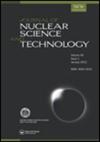Spatial evolution mechanism of vortex structure in the highly-loaded helium compressor cascade
IF 1.7
4区 工程技术
Q2 NUCLEAR SCIENCE & TECHNOLOGY
引用次数: 0
Abstract
ABSTRACTThe highly-loaded design method of helium compressors can effectively solve the difficulty in compressing helium in High Temperature Gas-cooled Reactors (HTGR). But it also causes obviously different attack angle characteristics of blade surface loads in a highly-loaded helium compressor compared to air compressors. This difference inevitably affects separation characteristics and flow loss within the compressor. In the current study, the effects of highly-loaded design methods and changes in attack angle on the separation characteristics of the compressor cascade are analyzed by applying a numerical simulation method firstly. Then the influence of Mach number on the loss characteristics of the cascade for a highly-loaded helium compressor is systematically analyzed. Finally, the effect of differences in the material properties of working fluid on the separation characteristics is discussed. The results indicate that the proportion of secondary flow loss to the total loss in highly-loaded compressor cascades is 2.46 times larger than that in conventionally-loaded ones. While properties of working fluid have an effect on the performance of the compressor cascade, their effects on the weight factor of vortex loss are highly limited.KEYWORDS: Helium compressorHigh temperature gas-cooled reactor (HTGR)HTGR type reactorhighly-loaded design methodSecondary flow lossTurbineClosed Brayton cycleSpecific heat ratioComputational fluid dynamicsDisclaimerAs a service to authors and researchers we are providing this version of an accepted manuscript (AM). Copyediting, typesetting, and review of the resulting proofs will be undertaken on this manuscript before final publication of the Version of Record (VoR). During production and pre-press, errors may be discovered which could affect the content, and all legal disclaimers that apply to the journal relate to these versions also. AcknowledgementThe present work is financially supported by the National Natural Science Foundation of China (No. 52206042), Natural Science Foundation of Liaoning Province (No. 2022-BS-096), Basic Research Project of Liaoning Provincial Department of Education(LJKMZ20220364).NomenclatureTableDisplay TableDeclaration of interest statementNo potential conflict of interest was reported by the author(s).Figure 1 Construction of highly-loaded helium compressor velocity triangleDisplay full sizeFigure 2 Schematic diagram of the geometric parameters of cascadesDisplay full sizeFigure 3 Schematic diagram of S3 sectional positionDisplay full sizeFigure 4 Schematic diagram of the calculation meshDisplay full sizeFigure 5 Axial vorticity diagrams for different grid numbers of exit sectionsDisplay full sizeFigure 6 Validation of numerical simulation methodDisplay full sizeFigure 7 Variation of total loss coefficients and pressure ratios with attack angle for helium compressor cascades of different design methodsDisplay full sizeFigure 8 Static pressure curves of blade surface with 50% blade height for different design methods (Ma=0.3)Display full sizeFigure 9 Programs of limiting streamlines and static pressure coefficients of cascade with different design methodsDisplay full sizeFigure 10 Diagrams of vortex structure of helium compressor cascades S3 sections with different design methods (Ma=0.3, i= 0°)Display full sizeFigure 11 Vortex loss weights of S3 sections of helium compressor cascades with different design methods (Ma=0.3, i= 0°)Display full sizeFigure 12 Diagrams of limit streamlines and static pressure coefficients at different angles of attack on the suction surface of a highly-loaded helium compressor cascadeDisplay full sizeFigure 13 Diagrams of axial vorticity at different attack angle S3 sections of a highly-loaded helium compressor cascadeDisplay full sizeFigure 14 Vortex loss weights of S3 sections of helium compressor cascade with different attack anglesDisplay full sizeFigure 15 Static pressure distribution on cascade surface of highly-loaded helium compressor under different incoming Mach numbersDisplay full sizeFigure 16 Diagrams of axial vorticity at different incoming Mach numbers for the S3 sections of a highly-loaded helium compressor cascadeDisplay full sizeFigure 17 Vortex loss weights of S3 sections of helium compressor cascades under different incoming Mach numberDisplay full sizeFigure 18 Variation of total pressure loss coefficient and pressure ratio with attack angle for compressor cascade with different working fluidDisplay full sizeFigure 19 Diagrams of static pressure ratio at 50% spanwise section for different working fluids (0.3Ma, i=0°)Display full sizeFigure 20 Diagrams of cascade S3 sections axial vorticity with different working fluid (Ma=0.3, i=0°)Display full sizeFigure 21 Vortex loss weights of S3 sections of different working fluid compressor cascadesDisplay full sizeAdditional informationFundingThe work was supported by the National Natural Science Foundation of China [52206042].高负荷氦压缩机叶栅涡结构的空间演化机制
摘要氦气压缩机的高负荷设计方法可以有效地解决高温气冷堆(HTGR)压缩氦气的难题。但高负荷氦气压缩机叶片表面载荷的攻角特性也与空压机明显不同。这种差异不可避免地影响分离特性和压缩机内部的流动损失。本研究首先采用数值模拟的方法,分析了高负荷设计方法和攻角变化对压气机叶栅分离特性的影响。然后系统分析了马赫数对高负荷氦气压气机叶栅损失特性的影响。最后,讨论了工质性质差异对分离特性的影响。结果表明:高负荷压气机叶栅二次流损失占总损失的比例是常规负荷的2.46倍;虽然工质性质对压气机叶栅的性能有影响,但对旋涡损失权重因子的影响非常有限。关键词:氦压缩机高温气冷堆(HTGR)HTGR型反应堆高负荷设计方法二次流损失sturbinclosed Brayton循环比热比计算流体动力学免责声明作为对作者和研究人员的服务,我们提供此版本的接受手稿(AM)。在最终出版版本记录(VoR)之前,将对该手稿进行编辑、排版和审查。在制作和印前,可能会发现可能影响内容的错误,所有适用于期刊的法律免责声明也与这些版本有关。本研究得到国家自然科学基金(No. 52206042)、辽宁省自然科学基金(No. 2022-BS-096)、辽宁省教育厅基础研究项目(LJKMZ20220364)资助。NomenclatureTableDisplay表利益声明声明作者未报告潜在的利益冲突。图1高负荷氦气压缩机速度三角形构造显示满尺寸图2叶栅几何参数示意图显示满尺寸图3 S3截面位置示意图显示满尺寸图4计算网格示意图显示满尺寸图5不同栅格数出口截面轴向涡量图显示满尺寸图6数值模拟方法验证显示满尺寸图7总量变化图8不同设计方法50%叶高时叶面静压曲线(Ma=0.3)显示满尺寸图9不同设计方法叶栅极限流线及静压系数程序显示满尺寸图10不同设计方法氦压气机叶栅涡结构示意图S3截面不同设计方法(Ma=0.3, i= 0°)显示全尺寸图11不同设计方法的氦压缩机叶栅S3段涡损权重(Ma=0.3, i= 0°)图12高负荷氦气压气机叶栅不同攻角下吸力面极限流线及静压系数图显示满尺寸图13高负荷氦气压气机叶栅不同攻角下轴向涡量图显示满尺寸图14不同攻角下氦气压气机叶栅S3段涡损失重量图显示满尺寸图15静压图16高负荷氦压气机叶栅S3段不同来流马赫数时轴向涡量图图17不同来流马赫数下氦压气机叶栅S3段涡损失重量图18总压损失系数和压比随攻角的变化图19不同工质(0.3Ma, i=0°)下50%展向截面静压比图图20不同工质(Ma=0.3, i=0°)下叶栅S3截面轴向涡量图图21不同工质压缩机叶栅S3截面的涡损重量显示尺寸附加信息基金资助本工作得到国家自然科学基金面上[52206042]的支持。
本文章由计算机程序翻译,如有差异,请以英文原文为准。
求助全文
约1分钟内获得全文
求助全文
来源期刊

Journal of Nuclear Science and Technology
工程技术-核科学技术
CiteScore
2.40
自引率
16.70%
发文量
116
审稿时长
2.3 months
期刊介绍:
The Journal of Nuclear Science and Technology (JNST) publishes internationally peer-reviewed papers that contribute to the exchange of research, ideas and developments in the field of nuclear science and technology, to contribute peaceful and sustainable development of the World.
JNST ’s broad scope covers a wide range of topics within its subject category, including but are not limited to:
General Issues related to Nuclear Power Utilization: Philosophy and Ethics, Justice and Policy, International Relation, Economical and Sociological Aspects, Environmental Aspects, Education, Documentation and Database, Nuclear Non-Proliferation, Safeguard
Radiation, Accelerator and Beam Technologies: Nuclear Physics, Nuclear Reaction for Engineering, Nuclear Data Measurement and Evaluation, Integral Verification/Validation and Benchmark on Nuclear Data, Radiation Behaviors and Shielding, Radiation Physics, Radiation Detection and Measurement, Accelerator and Beam Technology, Synchrotron Radiation, Medical Reactor and Accelerator, Neutron Source, Neutron Technology
Nuclear Reactor Physics: Reactor Physics Experiments, Reactor Neutronics Design and Evaluation, Reactor Analysis, Neutron Transport Calculation, Reactor Dynamics Experiment, Nuclear Criticality Safety, Fuel Burnup and Nuclear Transmutation,
Reactor Instrumentation and Control, Human-Machine System: Reactor Instrumentation and Control System, Human Factor, Control Room and Operator Interface Design, Remote Control, Robotics, Image Processing
Thermal Hydraulics: Thermal Hydraulic Experiment and Analysis, Thermal Hydraulic Design, Thermal Hydraulics of Single/Two/Multi Phase Flow, Interactive Phenomena with Fluid, Measurement Technology...etc.
 求助内容:
求助内容: 应助结果提醒方式:
应助结果提醒方式:


